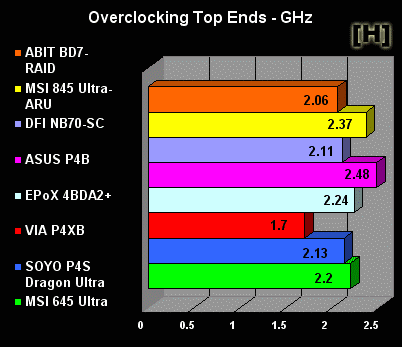Nu de prijs van de Pentium 4-processor gedaald is tot onder de 150 dollar, vond men bij HardOCP de tijd wel rijp voor een test van een aantal bijpassende mainboards op hun overklokbaarheid. Op de acht geteste borden zijn vier verschillende chipsets te vinden, te weten: Intel i845 (SDRAM), Intel i845D (266MHz DDR-RAM), SiS 645 (333MHz DDR-RAM), en de Via P4X266A (266MHz DDR-RAM). De processor werd gekoeld met een Sunflower Socket 478 cooler van AVC.
Op de borden werd tijdens de testen elke keer dezelfde Pentuim 4 gebruikt omdat de prestaties van deze processoren onderling ook nog kunnen verschillen. Verder werd het systeem opgebouwd met de volgende onderdelen: nVidia GeForce3 Ti500, IBM ATA-100 Deskstar 30GB, 256MB Corsair XMS2700 DDR333, Windows XP en de meest recente drivers. Met het aanpassen van de FSB en het voltage werden de volgende eindsnelheden bereikt:
 |
Opvallend detail in de grafieken behorende bij de verschillende benchmarks is het grote verschil in prestatie van het Asus P4B bord. Met de default instellingen blijft het duidelijk achter bij de anderen maar in overclockte staat stijgen de prestaties soms wel met 50%. In de uitgebreide conclusie worden zowel adviezen gegeven voor de die-hard overclocker als voor de mensen die liever een systeem hebben dat op de standaard snelheid draait. Een quote uit deze conclusie:
Pentium 4 motherboards need to be capable of delivering sufficient memory bandwidth in order to keep the processor busy executing instructions, rather than waiting on system memory. If you didn't know why to avoid any i845 board with PC133 memory support before, the preceding benchmarks may have clarified the situation. If not, consider the following analogy. Would you rather buy a Honda Civic, install a nitrous setup and pray for performance (without blowing your engine up) or spend a little extra on a Subaru Impreza WRX and enjoy the extra speed right off the showroom floor?At the same time, if you are buying a motherboard with the intention of overclocking it, you don't want something that is already operating at maximum capacity. VIA's P4X266A, while a great chipset in its stock form, leaves little room for optimization or at least it did on our particular sample supplied by VIA. Now that we've steered you clear of the i845 and P4X266A chipsets (for overclocking purposes anyway), let's focus on the i845D and SiS 645. (Also, at the time of writing this, the P4X333 is launching that will obviously cover the gap left by the P4X266A and its lacking support for DDR 333MHz.)
